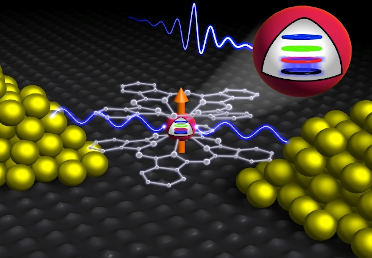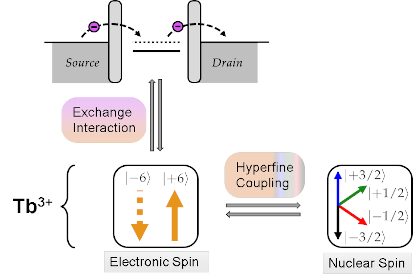Molecular Spin-Transistor: Quantum Information Processing Using Nuclear Spins in Single Molecule Magnets
-
Job Type:
PhD
- Contact Person:
Context: The molecular spin-transistor is one approach to access the spin degree of freedom of a single molecule magnet (SMM) to store information in the nuclear spin of a central magnetic atom, typically from the lanthanide (Ln) series. Therefore, a SMM is trapped inside a nanometer sized gap between two gold electrodes at millikelvin temperatures of a Sionludi dilution refrigerator. In this three-terminal device, the discrete energy levels of the molecule form a quantum readout dot, which is dominated by single-electron tunneling and sensitive to the molecule’s spin. A quantum non-demolishing readout of the stored information can be established using the hyperfine interaction between both molecular spins – nuclear and electronic – in the so-called spin-cascade. Experimentally, this is implemented by sweeping magnetic fields of up to one Tesla with superconducting 3D-vector magnets and low-noise electrical conductivity measurements. Efficient coupling of microwaves at this low temperature environment rounds off the experimental challenges and allows for the implementation of quantum information processing algorithms of such Qudits. The term Qudits refers to higher spin systems utilizing more states than conventional Qubits, where chemical engineering of intramolecular interactions can be used to further increase the accessible Hilbert space.
Objective: Investigation of coupled nuclear spins in Ln2-dinuclear complexes by readout and coherent manipulation of the resulting spin states.

Figure 1: A single TbPc 2 molecule is tunnel-coupled between two electrodes

Figure 2: Spin-cascade of the TbPc 2 SMM, coupling the terbium's nuclear spin to the readout dot via two stages.
Work plan: A low-noise electrical measuring system allows conduction spectroscopy using lock-in detection at 30mK in magnetic fields up to 1T. [1] An existing nanofabrication process using electron beam lithography and shadow evaporation of metals will be used to fabricate nanojunctions which allow the in-situ formation of nanogaps by the electromigration technique. The presence of a sufficiently coupled molecule inside the nanogap can be confirmed by measurement of the electric and magnetic signatures. [2] Quantum information processing techniques are to be implemented to explore the accessible Hilbert space of such coupled spin systems.
Reference:
[1] Electrical readout of individual nuclear spin trajectories in a single- molecule magnet spin transistor,
S. Thiele et al., W. Wernsdorfer, Phys. Rev. Lett. 111, 037203 (2013)
[2] Operating Quantum States in single magnetic molecules: Implementation of Grover’s quantum algorithm,
C. Godfrin et al., Phys. Rev. Lett. 119, 187702 (2017)
PDF version of the advertisement (ca. 215 kB) available here.

